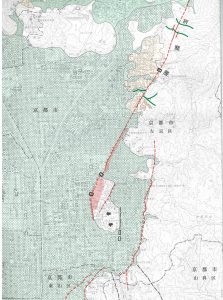The Zazen stone at Ginkaku-ji Temple (Higashiyama Jisho-ji Temple) is a stone placed in the Middle Ages to calm the anger of an active fault.
Yoshie Doi
 |
 |
Zazen stone in front of Togudo
We would like to express our deepest sympathies to everyone affected by the Noto Peninsula earthquake on New Year’s Day. We wish you a speedy recovery.
Japan, an earthquake-prone country, has a long history of earthquake countermeasures. In a sense, it was a mastery of how to interact with nature. In particular, Kyoto is surrounded by mountains created by active fault movements, forming the Kyoto Basin.
Shrines and temples are built where water gushes out from the cracks of active faults halfway up the mountain. Please see the active fault map. Active faults around Ginkaku-ji Temple are also described in the “Urban Area Active Fault Map Northeastern Kyoto 2nd Edition, Technical Data of the Geographical Survey Institute of Japan”.
I learned about this map during the Great Hanshin-Awaji Earthquake. I listened to a lecture by Professor Manabu Takahashi of Ritsumeikan University, and learned that the area that was a river in Kobe 6,000 years ago coincides with the area where the highway pier collapsed, and was unable to withstand the shaking of the earthquake. Just two weeks before the Great Hanshin Earthquake, it was predicted that an earthquake would occur in Kobe.
This is a method of predicting the next earthquake by examining the history of the land. Since then, I have carried out fieldwork many times with this active fault map.
Ginkaku-ji Temple (Higashiyama Jisho-ji Temple) is located in Kimon, northeast of Kyoto, and has the spring water of Ochanoisen. This Ochanoisen is located along a fault line, and there is a small stream in the Kitagawa River, which is said to often flood during heavy rains. Nowadays, an erosion control dam has been built upstream, and flooding has stopped.
In this area, the Hanaori Fault runs from Kutsuki in Shiga Prefecture along the Sabakaido Road, and the Hanaore Fault near Ginkakuji Temple branches off and runs along the east side of Ginkakuji’s garden, passing through Honen-in Temple and heading south. It is known that this fault moved frequently between 800 and 1700 AD, causing great damage.
It is said that the Zazen stone in Nishikikyoike Pond in front of Togudo Hall of Ginkakuji Temple and the Bentendo Hall next to the pond were built to calm this fault. In particular, near the surface of this fault, it splits into smaller faults, and you can see traces of the branching faults moving up and down. It is clear that the damage was significant. (See diagram)
The fact that this idea of calming the anger of active faults existed during the Ashikaga Shogunate era suggests that the relationship between nature and humans was viewed from the same perspective, and it is even moving. It has been believed that the land has a protective function in the invisible world, such as “barriers” and “keystones”.
Similarly, Tenchi Shihohai was an event where successive emperors faced heaven and earth on New Year’s Day and prayed for peace and prosperity for the country and its people. It is strange that prayer gives off energy and for some reason I feel a sense of peace as I enter the Kyoto Imperial Palace and Kyoto Gyoen National Garden. Prayer experiments are also being conducted at Harvard University. The charm of Kyoto comes from a thousand years of prayers in harmony with nature.
Yoshimasa Ashikaga, who built Ginkaku-ji Temple, was elected to the post of shogun at the age of 8, and was officially appointed as the shogun at the age of 15, the year of Genpuku. His life was probably at the mercy of adults at a young age.
Furthermore, although there is no evidence that there were any plans to cover Ginkaku-ji with silver leaf, it quickly became popular during the Edo period when a guidebook called “Rakuyo Famous Places Collection” introduced Higashiyama Jisho-ji as Ginkaku-ji. Ginkaku-ji is a very easy-to-understand name compared to Kinkaku-ji.
The end of document
Translated by Masami Otani
